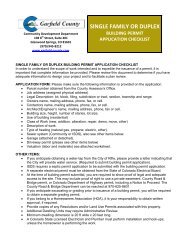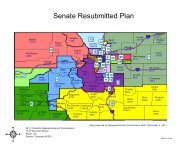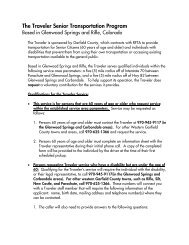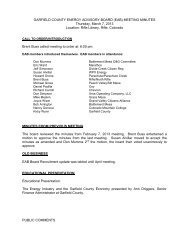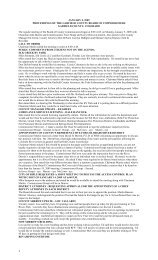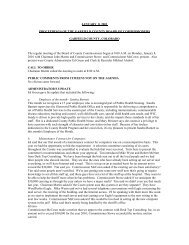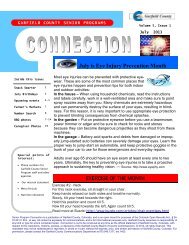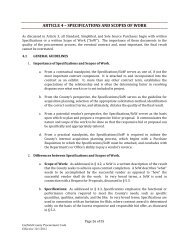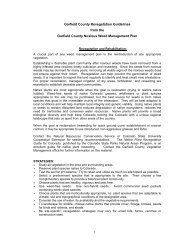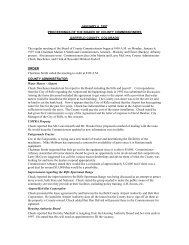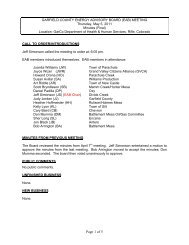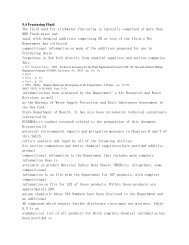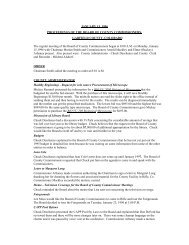Appendix D: Human Health Risk Assessment - Garfield County ...
Appendix D: Human Health Risk Assessment - Garfield County ...
Appendix D: Human Health Risk Assessment - Garfield County ...
Create successful ePaper yourself
Turn your PDF publications into a flip-book with our unique Google optimized e-Paper software.
<strong>Appendix</strong> D Screening Level <strong>Human</strong> <strong>Health</strong> <strong>Risk</strong> <strong>Assessment</strong> February 2011<br />
Battlement Mesa, Colorado <strong>Health</strong> Impact <strong>Assessment</strong> Colorado School of Public <strong>Health</strong><br />
Summary of Modifications:<br />
The following modifications to the September 2010 version of the risk assessment were<br />
made based on stakeholder comments and data that became available after September<br />
2010.<br />
1. Near a well pad has been defined as living within ½ mile of a well pad. This<br />
definition is based on odor complaints in July 2010 from residents living ½ mile<br />
from the Watson Ranch pad.<br />
2. An elderly adult is defined as aged 65 years or greater has been added as a<br />
receptor.<br />
3. A subchronic exposure scenario of 20 months for exposure to air emissions<br />
during well completion operations has been added. This is based on comments<br />
received in the citizen’s stakeholder meeting that some residents live within ½<br />
mile of more than one of the proposed well pads. Many individuals live within ½<br />
mile of two of the proposed pads and some live within ½ mile of three of the<br />
proposed pads. The subchronic exposure scenario was evaluated for all receptors<br />
(children, adults, and elderly adults). Previously an intermediate exposure of 10<br />
months was used, based on well-completion activities for 20 wells on one well<br />
pad.<br />
4. An acute exposure scenario of 7 days has been added for adults, including<br />
elderly adults.<br />
5. A baseline risk was estimated for Battlement Mesa residents based on ambient<br />
air samples collected at the Battlement Fire Station from September to<br />
November 2010.<br />
6. The exposure point concentrations used in the chronic risk assessment for all<br />
Battlement Mesa residents and for residents living near (within ½ mile) a well<br />
pad were updated to include data collected through November 2010.<br />
7. The exposure point concentrations for the subchronic exposure (previously<br />
defined as an intermediate exposure) used in the time-weighted average to<br />
estimate chronic exposure point concentrations for those living near a well pad<br />
were revised as follows. The maximum concentration and the 95%UCL from<br />
the 2008 Air Toxics Study and Antero’s August 2010 sampling was used to<br />
provide a range for subchronic exposure point concentration. If a contaminant<br />
was not measured in these studies, the maximum concentration from the Bell-<br />
Melton Ranch Monitoring station was used as the subchronic exposure point<br />
concentration. All subchronic exposure point concentrations were determined<br />
from data obtained from 24-hour integrated samples.<br />
8. Subchronic toxicity factors have been found for most contaminants of potential<br />
concern (COPCs) and were used to estimate the subchronic risk. If a subchronic<br />
toxicity factor was not available, the chronic toxicity factor was used, per EPA<br />
guidance (EPA 1989). A more thorough discussion of the bias this introduces has<br />
been added to the uncertainty section.<br />
9. The exposure point concentrations for the acute exposure to contaminants in air<br />
were revised as follows. The maximum concentration and 95% UCL from the<br />
2005 to 2007 grab samples collected when odors were noticed and the grab<br />
<strong>Appendix</strong> D page 11



